
|
BMe Research Grant |

|
Doctoral School of Information Science and Technology
Department of Telecommunications
Supervisor: Sandor Imre, DSc
Using Quantum-Based Solutions in Satellite Communications
Introducing the research area
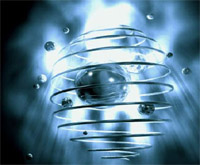 Quantum
computing offers revolutionary solutions in the field of computer sciences,
applying tools of quantum physics, which are incomparably numerous than those of
classical physics. Although quantum computers merely promise applications
for the far future, a few algorithms are already available for solving problems otherwise difficult to handle with traditional computers. Today's
telecommunication requires large amount of data transfer via satellites. An
interesting way of dealing with this problem might be using quantum
communication. Unlike the optical cable-based, wired quantum solutions, quantum satellite communication requires a free-space channel, which is
affected by various physical factors. Over the last years, we have developed a mathematical
model for examining satellite quantum communications. We have analysed the
redundancy-free quantum channel and developed redundancy-free quantum
codes.
Quantum
computing offers revolutionary solutions in the field of computer sciences,
applying tools of quantum physics, which are incomparably numerous than those of
classical physics. Although quantum computers merely promise applications
for the far future, a few algorithms are already available for solving problems otherwise difficult to handle with traditional computers. Today's
telecommunication requires large amount of data transfer via satellites. An
interesting way of dealing with this problem might be using quantum
communication. Unlike the optical cable-based, wired quantum solutions, quantum satellite communication requires a free-space channel, which is
affected by various physical factors. Over the last years, we have developed a mathematical
model for examining satellite quantum communications. We have analysed the
redundancy-free quantum channel and developed redundancy-free quantum
codes.
Brief introduction of the research place
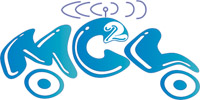 Mobile
Communication and Computing Laboratory at BME Department of Telecommunications has been
working on wireless and mobile systems for more than 10 years. Under the
leadership of Dr. Imre Sándor, several members of the laboratory have started dealing
with quantum informatics and numerous publications have been completed since
2003. At present, and three PhD dissertations are
in process.
Mobile
Communication and Computing Laboratory at BME Department of Telecommunications has been
working on wireless and mobile systems for more than 10 years. Under the
leadership of Dr. Imre Sándor, several members of the laboratory have started dealing
with quantum informatics and numerous publications have been completed since
2003. At present, and three PhD dissertations are
in process.
History and context of the research
In 1965, Gordon Moore studied the number of transistors that can be placed inexpensively on an integrated circuit[1]. The big question is that how long this trend – i.e the increase in the number of transistors – is going to continue?
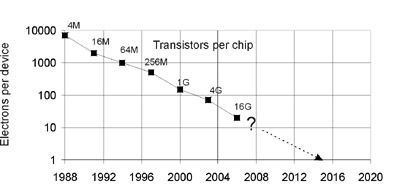
Researches offer different solutions to this problem, e.g. use of parallel
computers, DNS-technology or informatics based on quantum mechanics. Why quantum
mechanics? To allocate more transistors on an integrated circuit of a
given size, the size of individual transistors have to be reduced. At one point, we will
cross the borderline of atomic dimensions, where classical Ebers-Moll
equals are not valid anymore, and quantum mechanical models have to be used
instead [2].
Why are quantum-based approaches better than the classical ones? The power
of quantum
parallelism allows us to solve classically complex problems during a short
period of time. Grover-algorithm provides more efficient searches in unsorted databases [1].
We can build different quantum circuits and decrypt the keys of RSA with
the help of Shor-algorithm[2]. Quantum
cryptography provides new ways of transmitting information securely (BB84 and B92
protocols) [3]. In quantum
teleportation we use entangled pairs to
transport information between two points [4].
Aim of the research
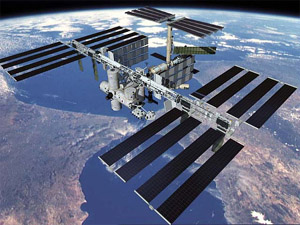 Free-space Quantum Key
Distribution (QKD) was first implemented over an optical path of about 30 cm
in 1991 [5]. In 2002, a research group demonstrated that free-space QKD is
possible in daylight [6]. In 2006, the distance was further extended to 144 km by an
international research group [7]. In 2008, the European Space
Agency named the quantum-based satellite communication as one of
the most important targets for the next five years. A European
consortium aims at establishing a space-to-Earth quantum-based communication experiment from the
International
Space Station [8].
Free-space Quantum Key
Distribution (QKD) was first implemented over an optical path of about 30 cm
in 1991 [5]. In 2002, a research group demonstrated that free-space QKD is
possible in daylight [6]. In 2006, the distance was further extended to 144 km by an
international research group [7]. In 2008, the European Space
Agency named the quantum-based satellite communication as one of
the most important targets for the next five years. A European
consortium aims at establishing a space-to-Earth quantum-based communication experiment from the
International
Space Station [8].
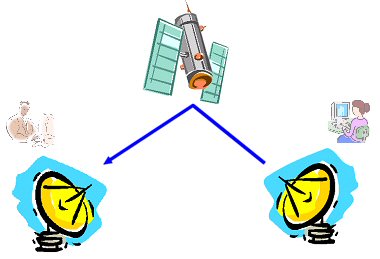 Free-space quantum communication can be extended to
ground-to-satellite or satellite-satellite quantum communication [9]. One of the
main advantages of using space for future quantum communication is achieving the level of loss-free and distortion-free optical communication. We have examined two
different protocols – the superdense coding [1]
and the BB84
[3].
Free-space quantum communication can be extended to
ground-to-satellite or satellite-satellite quantum communication [9]. One of the
main advantages of using space for future quantum communication is achieving the level of loss-free and distortion-free optical communication. We have examined two
different protocols – the superdense coding [1]
and the BB84
[3].
Another interesting question is related to quantum error correction. Currently many techniques are introduced but in these proposals redundancy is required for successful error correction. If we could use redundancy-free solutions, they would be very useful in the long-distance aerial communication, eliminating the need for redundant error correction codes used nowadays.
Methods
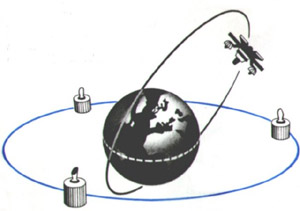 At present, using optical QKD is limited to a distance of
appr. 100 km, however, free-space quantum cryptography makes it possible
transmitting photons over long distances. We examined the physical properties of
the Earth-space and space-space channels to give some prescriptions about the
possible losses and to give some useful ideas about the implementation of such a
channel [10, 11]. We also developed an analytical model which describes one photon’s
(or a few photons’) behavior to simulate the communication process over a
satellite quantum channel. Our model enables us to analyze and determine the parameter requirements to the implementation of a satellite quantum channel for Earth-satellite and
satellite-satellite communication.
At present, using optical QKD is limited to a distance of
appr. 100 km, however, free-space quantum cryptography makes it possible
transmitting photons over long distances. We examined the physical properties of
the Earth-space and space-space channels to give some prescriptions about the
possible losses and to give some useful ideas about the implementation of such a
channel [10, 11]. We also developed an analytical model which describes one photon’s
(or a few photons’) behavior to simulate the communication process over a
satellite quantum channel. Our model enables us to analyze and determine the parameter requirements to the implementation of a satellite quantum channel for Earth-satellite and
satellite-satellite communication.
In a best case scenario of superdense coding,
Alice and Bob already share an entangled qubit pair, and thus every qubit sent by
Alice and arriving at Bob’s detector carries two bits of information. In the
statistical sense, the protocol is not worthwhile if more than half of the qubits
sent by Alice is not detected (in other words, if the transmittance is lower than
0.5). In this case, strong signals and classical protocols perform
better.
The most famous flexible asymmetrical protocol is the BB84
protocol. It is important to examine the performance and limits of
cryptography based on BB84 in various environments as well as to know the noise
parameters of the quantum channel, as errors appearing in the received quantum bits allow us to discover an eavesdropper.
We also used the analytical
methods to study the free-space quantum channel. Analytical
solutions were applied for constructing error coding methods to support redundancy-free
approaches.
Results
Based on our mathematical models, we were able to examine selected parameters
of quantum satellite communication. According to our results, the distance
between two satellites should be maximum 15,000 km to handle a successful BB84. These
results show that we can realize quantum communication over intercontinental
distances. However, after analyzing of LEO (Low Earth
Orbit) and GEO
(Geostationary Earth Orbit) satellite orbit, we can say that a BB84
supported equipment running on a LEO satellite cannot reach a GEO
satellite.
Another important question is how fast the satellites can
exchange keys with the BB84 depending on the distances. (The BB84 key
distribution protocol was published by Charles
H. Bennett and Gilles Bassard in 1984.
The algorithm working in wired system is a commercial product. Efficiency of
the free-space quantum channel is examined by this protocol.) We have shown that
the LEO orbits are better for the BB84. However, we extended our examinations to
the superdense coding algorithms, as well. (In superdense coding algorithm, we
need to send only one quantum bit instead of two classical bits.) According to
our results, superdense coding in a best case scenario is only worthwhile in
clear weather, at low zenith angles and for large detector mirror
sizes.
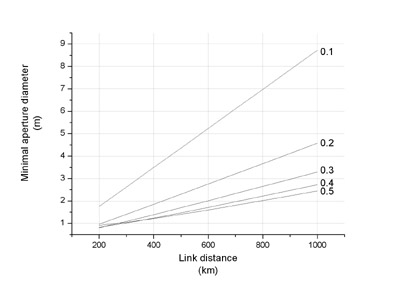
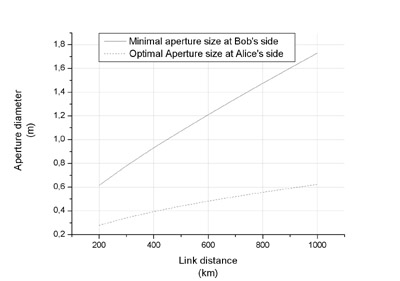
In another research, we would like to provide error correction by sending certain amount of qubits over a noisy quantum channel. The qubits are independent and each contains information that needs to be processed. We developed different redundancy-free solutions for free-space quantum communication.

We started with a special unitary channel, where the information itself was
classical, coded into qubits. The channel transforms a unitary transformation
with p probability and an identity transformation with 1-p probability. We can
construct an error coding description in which the classical states are coded
into the eigenvectors of the matrix of the unitary channel. We have shown that this
error-coding construction leads to a redundancy-free solution because we can
restore one quantum bit sent over the channel without any other (redundant)
information.

In the next step, we considered the redundancy-free implementation of a unitary error correcting operator. The protocol achieves the redundancy-free quantum communication using local unitary operations and unitary matrices. Our research is important because using these redundancy-free techniques effective capacity of the satellite link could be increased..
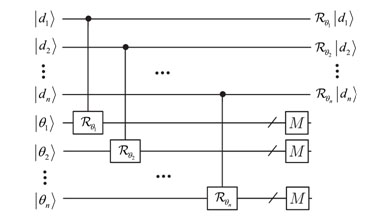
Expected impact and further research
Examining the connection of quantum informatics and satellite communication back in 2003 meant starting to deal with a field which gained more and more importance.
Our research area is even more interesting because it combines results of
mathematical modeling, information theory and engineering.
We have received
more article review requests. In this year we were invited to submit two
different book chapters.
In our further research, we would like to study the way can use entangled
pairs in redundancy-free coding. In another research topic, we examine how we
can improve self-adapting communication networks through the application of quantum-informatics-based solutions.
Publications, references, links
Publications
International journal articles
Laszlo Bacsardi
Satellite Communication Over Quantum
Channel
ACTA ASTRONAUTICA 61:(1–6) pp. 151–159.
(2007)
Laszlo Bacsardi
Using Quantum Computing Algorithms
in Future Satellite Communication
ACTA ASTRONAUTICA 57:(2–8) pp. 224–229.
(2005)
International book chapters
Laszlo Bacsardi, Sandor Imre
Quantum-Based Information Transfer in
Satellite Communication
Book: „Satellite Communications”, ISBN
978-953-7619-X-X, Sciyo (accepted, to appear)
Laszlo
Bacsardi, Laszlo Gyongyosi, Marton Berces, Sandor Imre
Quantum Solutions
for Future Space Communication
Book: „Quantum Computers”, Nova Science
Publishers (accepted, to appear)
Laszlo Bacsardi, Laszlo
Gyongyosi, Sandor Imre
Solutions for Redundancy-Free Error Correction in
Quantum Channel
LECTURE NOTES OF THE INSTITUTE FOR COMPUTER SCIENCES
SOCIAL-INFORMATICS AND TELECOMMUNICATIONS ENGINEERING 36: pp. 117–124.
(2010)
International conference papers
Mate Galambos, Laszlo Bacsardi, Sandor Imre
Modeling and Analyzing
the Quantum-Based Earth-Satellite and Satellite-Satellite
Communications
International Astronautical Congress 2010
(accepted)
L. Bacsardi, L. Gyongyosi, S. Imre
Using
Redundancy-free Quantum Channels for Improving the Satellite
Communication
In: Proceedings CD of 2nd International ICST Conference on
Personal Satellite Services. Rome, Italy, 2010.02.04–2010.02.05., pp.
1–14. Paper 8560.
L Bacsardi, L Gyongyosi, S Imre
Solutions
for Redundancy-Free Error Correction in Quantum Channel
In: Proceedings
CD of 1st International ICST Conference on Quantum Communication and Quantum
Networking. Vico Equense, Italy, 2009.10.26–2009.10.30., Gent: pp. 1–8.
Paper 8077. (ISBN: 978-963-9799-83-7)
L. Bacsárdi, M. Bérces,
S. Imre
Redundancy-Free Quantum Theory-Based Error Correction Method in Long
Distance Aerial Communication.
In: 59th International Astronautical
Congress, IAC Proceedings 2008. Glasgow,Great Britain, 2008.09.29–2008.10.03.
pp. 1–7. Paper IAC-08-B2.4.8.
Hungarian journal articles
László Bacsárdi, Máté Galambos, Sándor Imre
Quantum channel in
Earth-satellite and satellite-satellite communications
HÍRADÁSTECHNIKA
LXV:(3–4.) pp. 23–29. (2010)
Scientific lectures (in Hungarian)
László Bacsárdi
Teleporting with the speed of light – adventures in
the world of quantum informatics
Future's techniques, techniques from the
future, Sopron, Apr 14, 2010
László Bacsárdi, Sándor
Imre
The mistery of the root NOT gate - will have Mr. Moore a good night on
tomorrow?
Puskás Tivadar Távközlési Technikum, Budapest, March 29,
2010
László Bacsárdi
Using quantum informatics in
space telecommunication - could ET make a home-call faster than the speed of
light?
Gyula Fényi Astronomical Open University, Sopron, Nov 23,
2007
Links
Website of our university
lecture - Quantum Informatics and Communications
Selected web portals
Quantiki
Virtual Journal of Quantum
Information
The International Nanoscience Communicity
Quantum companies
id
Quantique (sells Quantum Key Distribution products)
MagiQ
Technologies (sells quantum devices for cryptography)
Quintessence Labs Solutions (based
on continuous wave lasers)
References
[1] S. Imre, B. Ferenc, ‘Quantum Computing and Communications: An Engineering
Approach’, (Wiley, 2005)
[2] Michael A. Nielsen, IsaacL. Chuang, ’Quantum
Computation and Quantum Information’ (Cambridge University Press, 2000)
[3]
Charles H. Benett, Gilles Bassard, ’Quantum Chryptography: Public Key
Distribution and Coin Tossing’, Internation Conference on Computers, Systems
& Signal Processing, Bangalore, India (December 10–12, 1984)
[4]
Teleporting an Unknown Quantum State via dual Classical and
Einstein-Podolsky-Rosen Channels, C. H. Bennett, G. Brassard, C. Crépeau, R.
Jozsa, A. Peres, W. K. Wooters, (Phys. Rev. Lett, vol. 70, n 13, pp. 1895, March
1993)
[5] C. H. Bennett et al., Lecture Notes In Computer Science 473, 253
(1991).
[6] Richard J. Hughes, Jane E. Nordholt, Derek Derkacs and Charles G.
Peterson, Practical free-space quantum key distribution over 10 km in daylight
and at night, (New Journal of Physics 4 (2002) 43.1–43.14 )
[7] Tobias
S-Manderbach, et al., ’Experimetal Demostration of Free-Space Decoy-State
Quantum Key Distribution over 144km’, Phys. Rev. Lett. 98, 010504 (2007)
[8]
Josep Maria Predigues Armengol, et al., ’Quantum Communications at ESA: Towards
a space experiment on the ISS’, Acta Astronautica 63, 165–178 (2008)
[9] L.
Bacsardi, Satellite Communication Over Quantum Channel., Acta Astronautica
61:(1–6) pp. 151–159, 2007
[10] Larry C. Andrews and Ronald L. Phillips, ’
Laser Beam Propagation through Random Media’, (SPIE Press Book, 2005)
[11] C.
Bonato et al., ’Polarization transformation induced on qubits in a
Space-to-Earth quantum communication link’, Quantum Electronics and Laser
Science Conference (2007)
Source of the figures: Wikipedia, free-to-use pictures, official logo of
the Mobile Communication and Computing Laboratory, self-made
figures.
